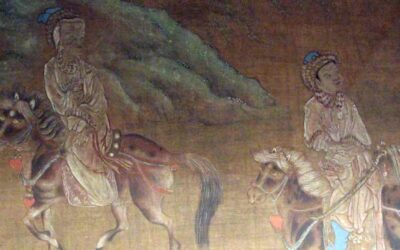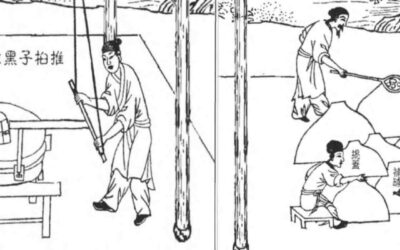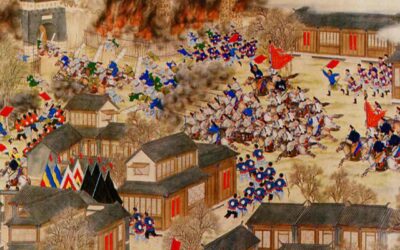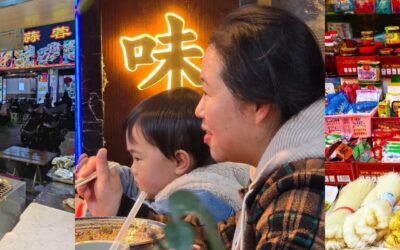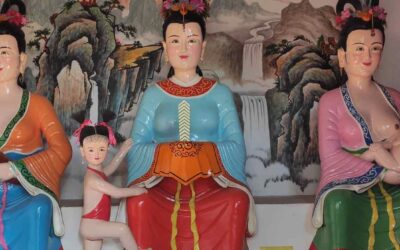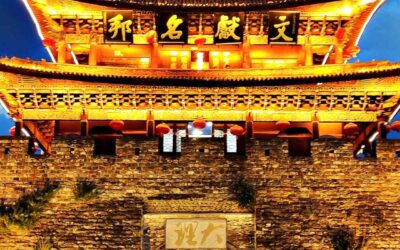The Bull that Shaped the World and Other Sacred Bovines among the Bulang Minority
The Bulang people (布朗族), an Austroasiatic ethnic group primarily inhabiting Yunnan’s tea-growing highlands, revere the ox as a sacred being intertwined with creation, agriculture, and spiritual power. The ox appears in their myths, agricultural rituals, festivals, and social customs, representing strength, prosperity, and spiritual connection. The Bulang’s ox traditions are uniquely tied to tea cultivation, cosmic order, and ancestral blessings.
In the Beginning, There Was the Ox
Among some Bulang, the ox is considered a sacred animal that helped in creation or provided sustenance to early humans. The creation myth Gumiye tells of a big ox that created everything that exists in this world. After the creation was completed, he used his four legs to keep the heaven stable. In some versions, the ox plowed the earth with its horns, creating mountains and valleys, its sweat formed rivers, and its breath brought wind, allowing life to flourish.
The Ox and the Beginning of Agriculture
There are also tales that link the ox to the origins of agriculture. One legend tells of a heavenly ox that descended to earth carrying the first grains of rice or millet in its mouth (or dung). In another one, a Bulang ancestor followed the ox and discovered that where it rested, crops sprouted. In some others, the ox then taught people how to plow and sow, linking it to the origin of farming, or a divine or heroic ox teaches the Bulang people farming techniques, emphasizing the animal’s role in their transition from hunting to agriculture.
These myths explain why the ox has a central role in some rituals related to the traditionally swidden (slash-and-burn) agriculture. Its presence is especially important in the Plowing Ceremonies, performed before planting, when rituals are performed to honor the ox; and in Thanksgiving Festivals, after harvest, when Bulang communities express gratitude to the ox for its work. They decorate cattle, feed them special foods, and perform dances. In some places, the Ox Dance (牛舞) imitates ox movements, symbolizing fertility and strength.
The Ox and the Origin of Tea
Other myths relate it to tea. They tell of a demon (or drought spirit) that devoured crops until a sacred ox challenged it. The ox fought the demon for days, finally trampling it into the earth. Where the demon’s blood fell, the first tea plants grew. The ox then collapsed, and its body became a mountain that protected the village. Other versions state that after the battle, the people discovered that where an ox’s blood fell, the first tea plants appeared. The transformation of blood into tea is unique to the Bulang. Some of their tea fields are protected by oxen heads, and in some villages in Mengsong (勐宋) district, they perform ox sacrifices during tea-harvesting ceremonies, recalling the myth.
Spiritual Role of the Ox
The ox also has a sacrificial and spiritual role. Due to its ability to communicate with heavenly deities, it is sacrificed to honor ancestors or deities, believing that it will carry the prayers to the spirit world. Oxen are also central to other festivals. In New Year and Harvest Festivals, the ox is sometimes paraded or decorated. In some villages, an ox made of dough or straw is offered to ancestors, mirroring the cosmic ox’s sacrifice. In Xishuangbanna, the «Gangyong» (岗永) Festival includes a ritual ox sacrifice to pray for rain/harvest, tied to the demon-slaying myth. In Lincang, they have an Ox King Festival, held on the 8th day of the 4th lunar month (similar to Han Chinese Ox King festivals), which focuses on thanking oxen for labor—feeding them sticky rice and let them rest the whole day.
Ox bones are perceived as full of magical power, and they are used sometimes in traditional divination. There are no studies to ascertain if this was an independent development or could be related to the Oracle Bone divination practiced in China more than 3,000 years ago.
Conclusion
The ox in Bulang culture is more than just a farm animal—it embodies labor, sustenance, and spiritual connection. Its presence in myths, rituals, and daily life underscores its role as a symbol of resilience, prosperity, and communal harmony. Its economic and religious value makes the ox second only to people in Bulang symbolic thought. Owning cattle was historically a sign of prosperity among them, and oxen were used in trade or as bride prices in marriages.
About me: I have spent 30 years in China, much of the time traveling and studying this country’s culture. My most popular research focuses on Chinese characters (Chinese Characters: An Easy Learning Method Based on Their Etymology and Evolution), Matriarchy in China (there is a book with this title), and minority cultures (The Naxi of Southwest China). In my travels, I have specialized in Yunnan, Tibet, the Silk Road, and other lesser-known places. Feel free to write to me if you’re planning a trip to China. The agency I collaborate with offers excellent service at an unbeatable price. You’ll find my email below.
Last posts
The tragedy of the beauty Wang Zhaojun
The tragedy of the beauty Wang Zhaojun Emperor Yuan (48–33 BCE) had a large harem and could not meet with all the palace women regularly. Therefore, he ordered painters to create portraits of them, and he would summon them for favors based on these portraits. Most of...
The economics of human plowing
The economics of human plowing According to “The Exploitation Of The Works Of Nature”, a 17th century Chinese book. In farming households where there are no oxen to use, farmers fix a pole to the plough and two men pull the plough by placing the pole on their...
The Muslim rebellion in 19th century Yunnan
The Muslim Rebellion in Yunnan in 19th century. This is the first English translation of Émile Rocher’s book on the Panthay Rebellion. Originally published in 1879 as La Province chinoise du Yunnan, is a valuable firsthand account of Yunnan during the mid-19th...
Kunming Scenes 2025-feb
The World of Noodles If the variety of wheat or rice noodles found in China is already enough to fill an entire book, an appendix should be dedicated to noodles made from other ingredients. It seems that any vegetable that can be turned into flour only needs a bit of...
Sexual aspects of Gu venom
Gu illness resulted from a contamination by gu poison, which a recent analyst has characterized as “an alien evil spirit which entered [the] body and developed into worms or some similar animal that gnawed away at the intestines or genitalia.” This poison was thought...
Sunset in Dali
No Words Fuxing Rd from the South Gate. Dali, Yunnan.Corner in Fuxing Rd, Dali, Yunnan.Night market at the south of the South Gate. Dali. YunnanLast posts





